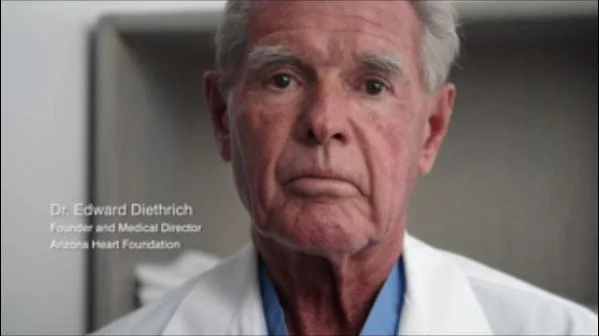
May 6, 2015 — The Organization for Occupational Safety in Interventional Fluoroscopy (ORSIF) announced the release of a new documentary film on the impact of chronic, low-level exposure to ionizing radiation on physicians that practice interventional medicine in fluoroscopy labs. The documentary features noted heart surgeon Edward Diethrich, M.D., founder of the Arizona Heart Foundation.
Diethrich experienced several health issues directly linked to radiation exposure, including cataracts in both eyes and dense, calcific plaque in his carotid artery. What impacted his career as a surgeon, however, was a diagnosis of an oligodendroglioma – a brain tumor.
Referring to his work as an endovascular surgeon, Diethrich notes in the documentary: "When we started doing these procedures, nobody questioned what we did. The last thing I was thinking about was how much radiation am I exposed to. Being a doctor, my whole motive was to help the patient get well. I didn't think about the hazardous conditions."
Interventional procedures performed in close proximity to radiation sources, such as coronary angioplasty and vascular surgery, as well as those under the electrophysiology and interventional neurology medical specialties, pose an ongoing health risk for fluoroscopy lab employees. In addition, serious orthopedic and musculoskeletal health issues are common among physicians and staff as a result of the heavy, traditional lead-lined protective gear worn in fluoroscopy labs.
"Dr. Diethrich communicates a very powerful message in this video, which is that hospital administrators, staff and regulators need to do a better job of recognizing this hidden hazard and understanding the serious health risks linked to occupational radiation exposure. A collaborative effort is needed as we work together toward creating safer work environments for those professionals whose primary focus is saving the lives of others," stated Michael Seymour, MS, MPH, CIH, ORSIF director of advocacy programs.
Diethrich, who has undergone treatment for his tumor, describes himself as "a living example of excessive radiation and what it can do to tissue," adding, "I think I felt this radiation cannot hurt me. I felt indestructible. Obviously, I didn't know what I was talking about," he added.
The complete video can also be accessed at https://youtu.be/rXgt0bF3GJM.
For more information: www.orsif.org
Related Content on Interventiopnal Lab Staff Radiation Exposure
Defining the Cath Lab Workplace Radiation Safety Hazard
VIDEO: Technologies and Techniques to Reduce Radiation Dose in the Cardiac Cath Lab — Interview with Akshay Khandelwal, M.D.
VIDEO: Reducing Cath Lab Radiation Dose at Henry Ford Hospital
Helping Interventional Cardiologists Reduce Exposure to Ionizing Radiation
14 Ways to Reduce Radiation Exposure on the Cath Lab


 April 25, 2025
April 25, 2025 








